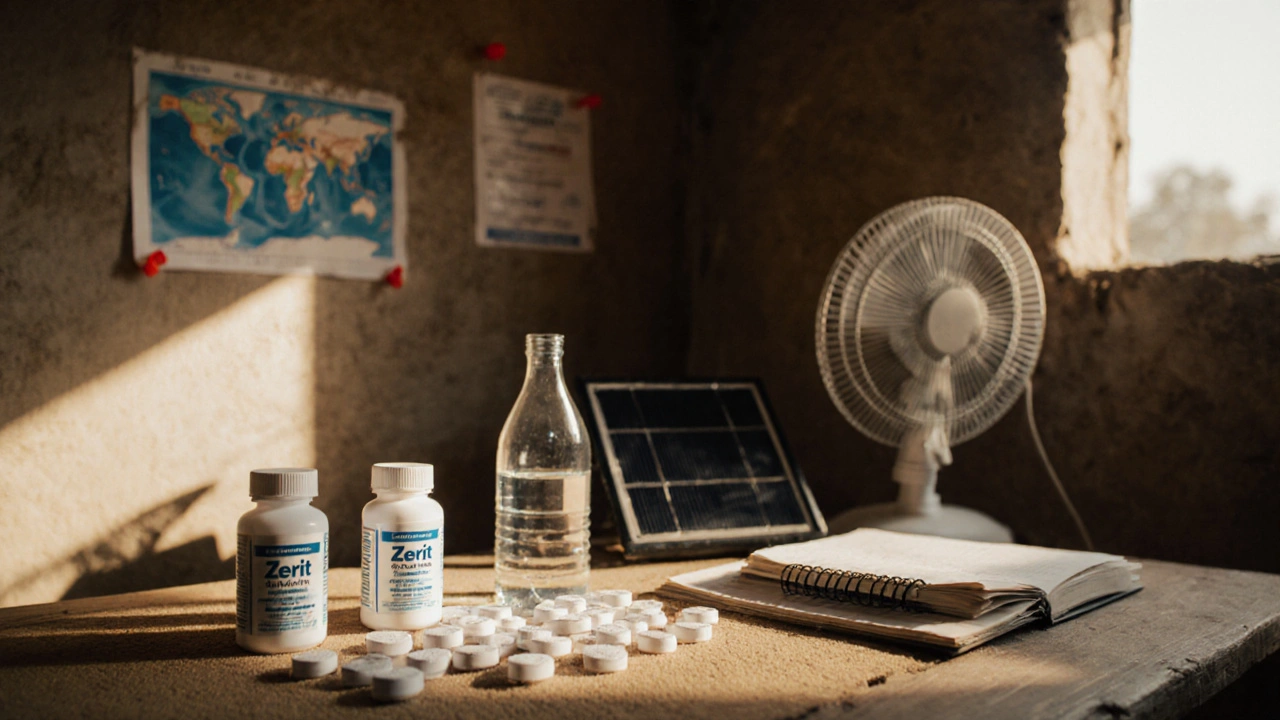HIV Medication Comparison Tool
Zerit (Stavudine)
A first-generation NRTI that was widely used in resource-limited settings due to its low cost and stability. Known for causing peripheral neuropathy and lactic acidosis.
Tenofovir Disoproxil Fumarate (TDF)
A newer NRTI with high efficacy and low resistance potential. Well-tolerated with fewer serious side effects compared to older drugs.
Zidovudine (AZT)
First NRTI approved for HIV treatment. Effective but associated with anemia and mitochondrial toxicity.
Lamivudine (3TC)
Well-tolerated cytidine analogue that pairs well with other drugs. Low risk of resistance development.
Efficacy Comparison Chart
Important Note
Modern HIV treatment guidelines recommend using newer agents with better safety profiles and lower resistance rates. Zerit is rarely used today due to its significant side effect profile, particularly peripheral neuropathy and lactic acidosis.
Always consult with your healthcare provider to determine the best treatment option for your specific situation.
When the global HIV crisis surged in the 1990s, Zerit (Stavudine) is a nucleoside reverse‑transcriptase inhibitor (NRTI) that was widely adopted in low‑resource settings because it was cheap and easy to produce. Over the years, newer drugs have entered the scene, but many clinicians still wonder if Zerit still has a place in modern regimens. If you’re weighing Zerit (Stavudine) against newer drugs, keep reading.
What Is Zerit (Stavudine) and How Does It Work?
Stavudine is a thymidine analogue that blocks the HIV reverse‑transcriptase enzyme, preventing the virus from copying its genetic material. It is taken orally, usually 30mg twice daily for adults, and reaches peak plasma levels within an hour. Because it doesn’t need a refrigerated supply chain, it became a staple in many national HIV programs, especially in sub‑Saharan Africa.
While it can suppress viral load effectively, its efficacy is generally considered comparable to other first‑generation NRTIs like zidovudine, but its safety profile is less favorable. Understanding why clinicians now often prefer other agents starts with looking at the data on viral suppression, resistance, and side‑effect rates.
Efficacy Compared to Common Alternatives
Modern antiretroviral therapy (ART) usually combines two NRTIs with a third agent from a different class. Below we compare Zerit with the most frequently used alternatives.
- Tenofovir disoproxil fumarate (TDF) is a nucleotide analogue that offers strong viral suppression and a high barrier to resistance.
- Zidovudine (AZT) is the first NRTI approved for HIV, known for its ability to reduce viral load quickly but also for causing anemia.
- Lamivudine (3TC) is a cytidine analogue that pairs well with many other drugs and is well‑tolerated.
- Efavirenz (EFV) is a non‑nucleoside reverse‑transcriptase inhibitor (NNRTI) often used as the third drug in first‑line regimens.
Clinical trials in the early 2000s showed that TDF‑based regimens achieved median viral loads <50 copies/mL in about 85% of patients after 48weeks, whereas stavudine‑based regimens hovered around 70‑75% in similar populations. The difference may seem modest, but when you scale it to millions of people, it translates into many more treatment failures and potential resistance.

Safety Profile: Side Effects You Should Expect
Safety is the main reason many programs have phased out Zerit. The drug is notorious for mitochondrial toxicity, which shows up as peripheral neuropathy, lipoatrophy (fat loss from the face and limbs), and, in rare cases, lactic acidosis.
In contrast, TDF’s most common concerns are renal dysfunction and bone mineral density loss, both of which can be monitored with routine labs. Zidovudine can cause anemia and neutropenia, while lamivudine is one of the best‑tolerated NRTIs, with headache and mild nausea being the most reported complaints. Efavirenz is associated with vivid dreams and central nervous system effects, especially during the first weeks of therapy.
For patients with pre‑existing neuropathy or who are at risk for metabolic complications, most clinicians now opt for TDF or lamivudine over stavudine.
Cost and Accessibility: Why Price Still Matters
When stavudine was first introduced, its price per tablet was under US$0.02, making it attractive for national procurement programs. Today, generic TDF and lamivudine are available for roughly US$0.05-0.07 per tablet, a modest rise but still affordable.
However, the total cost of care includes lab monitoring for toxicity. Because stavudine requires frequent checks for lactic acidosis (liver enzymes, lactate levels), the hidden expense can outweigh its cheap purchase price. A 2023 WHO cost‑effectiveness analysis estimated that switching from stavudine to TDF saved an average of US$30 per patient per year when accounting for monitoring and treatment of adverse events.
If you are in a setting where drug procurement budgets are tight, consider the full financial picture-not just the headline price.
Guideline Recommendations and When to Use Zerit
The World Health Organization (WHO) is the leading global authority that issues treatment guidelines for HIV removed stavudine from its first‑line recommendations in 2010, citing toxicity concerns. The United States DHHS (Department of Health and Human Services) follows a similar stance, listing TDF/FTC (emtricitabine)+EFV as the preferred regimen for most adults.
That said, stavudine can still be useful in very specific scenarios: patients with severe renal impairment (where TDF is contraindicated) and those who have limited access to newer drugs due to patent restrictions. In such cases, the clinician must weigh the risk of neuropathy against the benefit of preserving kidney function.
Choosing the Right Regimen: A Quick Decision Checklist
- Assess baseline kidney function (eGFR). If <60mL/min, consider stavudine only if other options aren’t available.
- Check for pre‑existing peripheral neuropathy or diabetes-conditions that increase the risk of stavudine toxicity.
- Review CD4 count is a measure of immune system health used to gauge HIV disease progression and viral load; patients with high viral loads may benefit from the stronger suppressive power of TDF‑based regimens.
- Consider cost: add monitoring expenses to the drug price. If budget permits, prioritize TDF or lamivudine.
- Check national formularies or insurance coverage-many programs now reimburse only WHO‑recommended drugs.
Follow the checklist, discuss options with the patient, and document the rationale for any deviation from guideline‑preferred therapy.
Comparison Table: Zerit vs Common Alternatives
| Drug | Class | Typical Adult Dose | Key Side Effects | WHO Recommendation (2024) | Approx. Monthly Cost (USD) |
|---|---|---|---|---|---|
| Zerit (Stavudine) | NRTI | 30mg twice daily | Peripheral neuropathy, lipoatrophy, lactic acidosis | Not recommended for first line | ~2 |
| Tenofovir (TDF) | Nucleotide RTI | 300mg once daily | Renal toxicity, bone loss | Preferred NRTI backbone | ~5 |
| Zidovudine (AZT) | NRTI | 300mg twice daily | Anemia, neutropenia | Second‑line option | ~4 |
| Lamivudine (3TC) | NRTI | 150mg twice daily | Mild nausea, headache | Preferred backbone with TDF | ~3 |
| Efavirenz (EFV) | NNRTI | 600mg once daily | Dizziness, vivid dreams | Standard third agent | ~6 |
Frequently Asked Questions
Is stavudine still available in pharmacies?
Yes, generic stavudine is produced in several countries, but many national formularies have removed it from routine use. It may still be stocked for rescue therapy or specific renal‑impairment cases.
Can I switch from Zerit to TDF without a break in treatment?
Switching is usually safe if viral load is suppressed and CD4 count is stable. Physicians often perform a “direct switch” and continue monitoring labs for the first 12 weeks.
What monitoring is required for stavudine toxicity?
Baseline lactate, liver enzymes, and a neuropathy exam are recommended. Follow‑up labs every 3months for the first year, then semi‑annually, help catch lactic acidosis early.
Why does WHO prefer TDF over stavudine?
Because TDF provides stronger viral suppression, has a lower risk of severe mitochondrial toxicity, and the overall cost‑effectiveness is better when monitoring expenses are included.
Is there a pediatric formulation of stavudine?
A syrup version existed but is rarely used today. Pediatric regimens now favor fixed‑dose combinations of TDF/lamivudine with appropriate dosing based on weight.


Comments
Angie Wallace
Finding a therapy that fits your lifestyle and side‑effect tolerance makes the biggest difference.
October 9, 2025 at 14:40
Doris Montgomery
Stavudine is an outdated relic that most clinicians skip.
October 17, 2025 at 17:06
Nick Gulliver
Our country's early fight against HIV showed the value of cheap drugs like stavudine, yet modern science proves we deserve better, and clinging to old meds betrays progress.
October 25, 2025 at 19:33
Sadie Viner
When evaluating antiretroviral options, clinicians must weigh efficacy, resistance barriers, and toxicity profiles with meticulous rigor; tenofovir offers a superior virologic suppression rate while minimizing mitochondrial insults, whereas stavudine, despite its historical affordability, incurs peripheral neuropathy and lactic acidosis that jeopardize patient adherence; consequently, contemporary guidelines prioritize agents with favorable safety margins, reserving stavudine for exceptional circumstances where cost constraints are absolute.
November 2, 2025 at 22:00
Kristen Moss
We gotta remember that cheap meds like stavudine helped a lot of folks here, but today we can do better.
November 11, 2025 at 00:26
Rachael Tanner
In the pharmacologic lexicon, stavudine sits as a muted footnote, eclipsed by the vibrant efficacy of tenofovir, which dazzles with a ninety‑percent suppression metric.
November 19, 2025 at 02:53
Debra Laurence-Perras
While respecting the historical impact of stavudine in low‑resource settings, we encourage patients to explore newer combinations that harmonize safety and potency.
November 27, 2025 at 05:20
dAISY foto
Yo fam, the old school stavudine might have been a lifesaver back then, but now we got slicker drugs that keep ya feeling fresh and vibin.
December 5, 2025 at 07:46
Write a comment